To Evaluate the State of Child Obesity in UK: A Healthcare Case Study
VerifiedAdded on 2020/06/03
|15
|2160
|122
Report
AI Summary
This research project evaluates the state of child obesity in the United Kingdom, focusing on healthcare services. The study identifies the primary causes of obesity in children, including food consumption behavior, lack of physical activity, and community environment. It explores the health effects of obesity, such as cardiovascular diseases, high cholesterol, asthma, and psychological issues. The research also examines ways to prevent obesity, emphasizing healthy lifestyles, balanced diets, and increased physical activity. The methodology includes both primary and secondary data sources, employing questionnaires to gather insights from respondents. The analysis of the data reveals that children aged 8-12 are most prone to obesity, and that a combination of nutrition and physical activity is crucial for a healthier lifestyle. The report recommends interventions to promote healthier habits among children, including encouraging balanced diets, promoting physical activity, and educating children about healthy lifestyles.
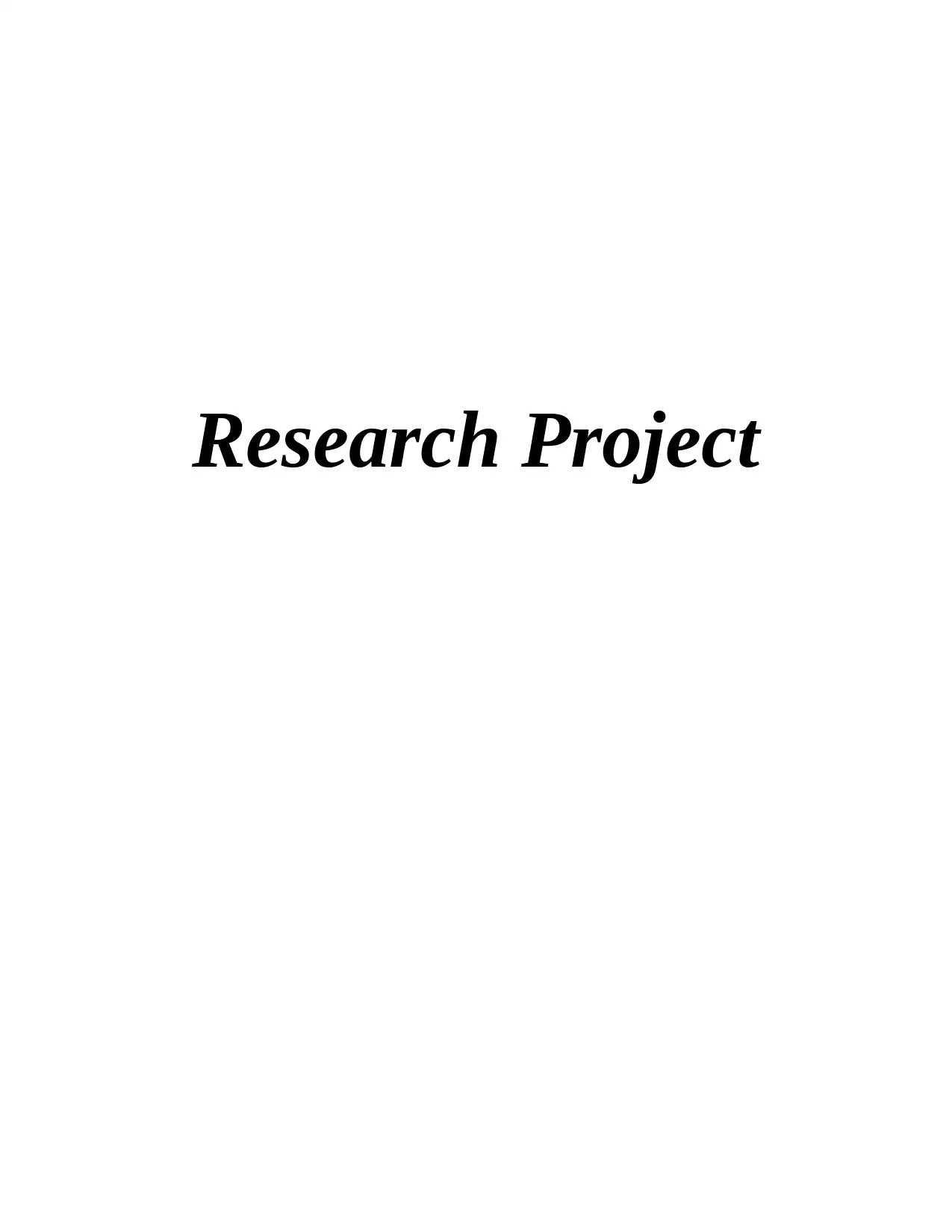
Research Project
Secure Best Marks with AI Grader
Need help grading? Try our AI Grader for instant feedback on your assignments.
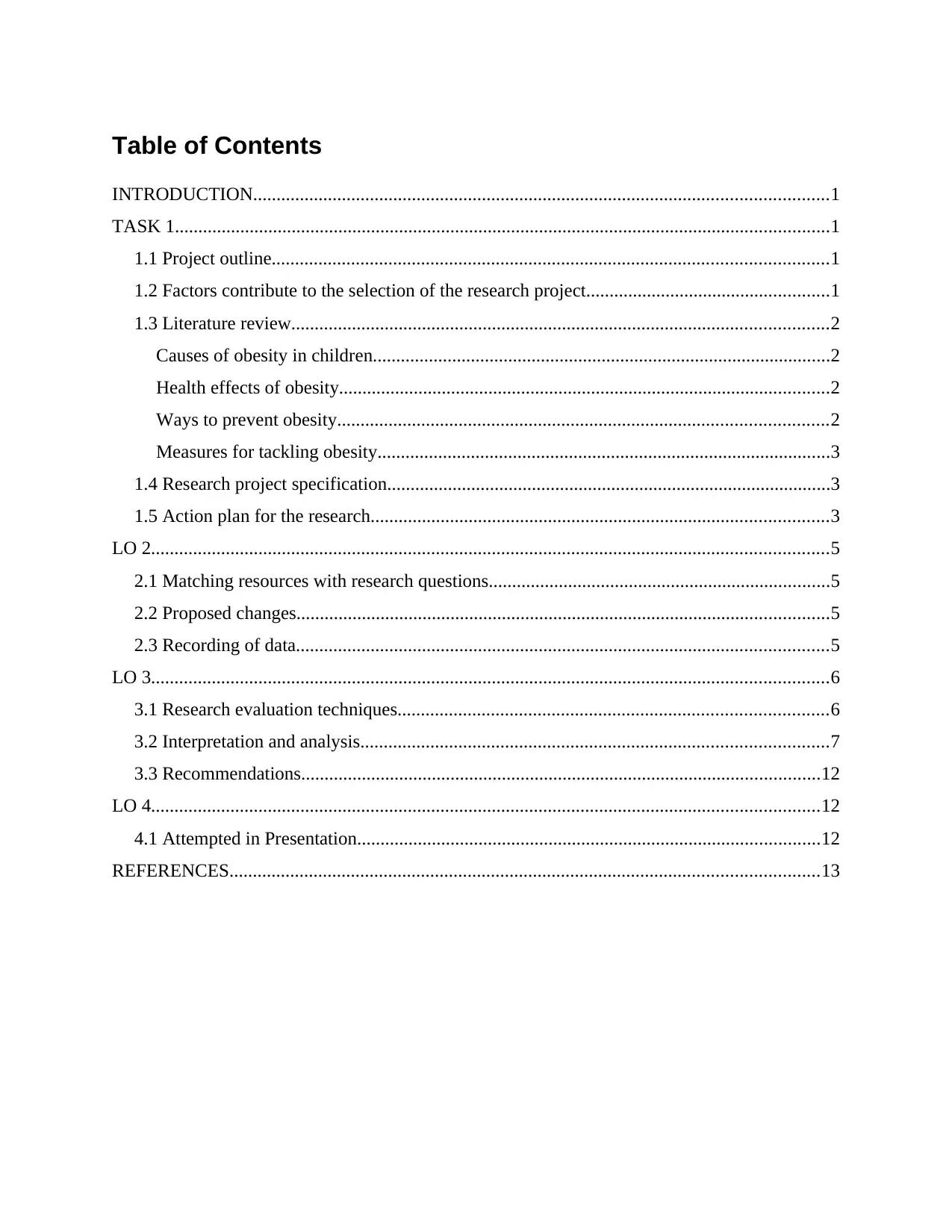
Table of Contents
INTRODUCTION...........................................................................................................................1
TASK 1............................................................................................................................................1
1.1 Project outline.......................................................................................................................1
1.2 Factors contribute to the selection of the research project....................................................1
1.3 Literature review...................................................................................................................2
Causes of obesity in children..................................................................................................2
Health effects of obesity.........................................................................................................2
Ways to prevent obesity.........................................................................................................2
Measures for tackling obesity.................................................................................................3
1.4 Research project specification...............................................................................................3
1.5 Action plan for the research..................................................................................................3
LO 2.................................................................................................................................................5
2.1 Matching resources with research questions.........................................................................5
2.2 Proposed changes..................................................................................................................5
2.3 Recording of data..................................................................................................................5
LO 3.................................................................................................................................................6
3.1 Research evaluation techniques............................................................................................6
3.2 Interpretation and analysis....................................................................................................7
3.3 Recommendations...............................................................................................................12
LO 4...............................................................................................................................................12
4.1 Attempted in Presentation...................................................................................................12
REFERENCES..............................................................................................................................13
INTRODUCTION...........................................................................................................................1
TASK 1............................................................................................................................................1
1.1 Project outline.......................................................................................................................1
1.2 Factors contribute to the selection of the research project....................................................1
1.3 Literature review...................................................................................................................2
Causes of obesity in children..................................................................................................2
Health effects of obesity.........................................................................................................2
Ways to prevent obesity.........................................................................................................2
Measures for tackling obesity.................................................................................................3
1.4 Research project specification...............................................................................................3
1.5 Action plan for the research..................................................................................................3
LO 2.................................................................................................................................................5
2.1 Matching resources with research questions.........................................................................5
2.2 Proposed changes..................................................................................................................5
2.3 Recording of data..................................................................................................................5
LO 3.................................................................................................................................................6
3.1 Research evaluation techniques............................................................................................6
3.2 Interpretation and analysis....................................................................................................7
3.3 Recommendations...............................................................................................................12
LO 4...............................................................................................................................................12
4.1 Attempted in Presentation...................................................................................................12
REFERENCES..............................................................................................................................13
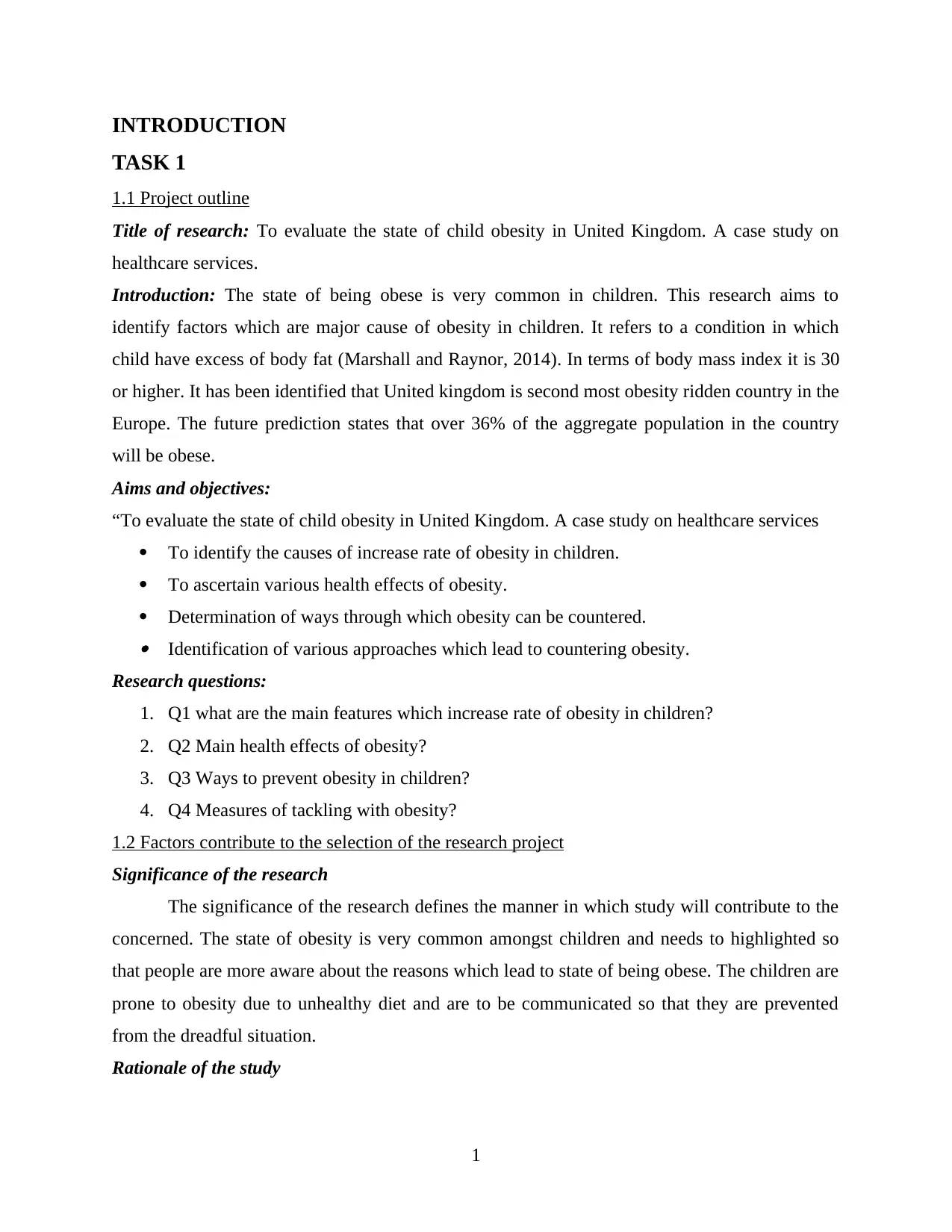
INTRODUCTION
TASK 1
1.1 Project outline
Title of research: To evaluate the state of child obesity in United Kingdom. A case study on
healthcare services.
Introduction: The state of being obese is very common in children. This research aims to
identify factors which are major cause of obesity in children. It refers to a condition in which
child have excess of body fat (Marshall and Raynor, 2014). In terms of body mass index it is 30
or higher. It has been identified that United kingdom is second most obesity ridden country in the
Europe. The future prediction states that over 36% of the aggregate population in the country
will be obese.
Aims and objectives:
“To evaluate the state of child obesity in United Kingdom. A case study on healthcare services
To identify the causes of increase rate of obesity in children.
To ascertain various health effects of obesity.
Determination of ways through which obesity can be countered. Identification of various approaches which lead to countering obesity.
Research questions:
1. Q1 what are the main features which increase rate of obesity in children?
2. Q2 Main health effects of obesity?
3. Q3 Ways to prevent obesity in children?
4. Q4 Measures of tackling with obesity?
1.2 Factors contribute to the selection of the research project
Significance of the research
The significance of the research defines the manner in which study will contribute to the
concerned. The state of obesity is very common amongst children and needs to highlighted so
that people are more aware about the reasons which lead to state of being obese. The children are
prone to obesity due to unhealthy diet and are to be communicated so that they are prevented
from the dreadful situation.
Rationale of the study
1
TASK 1
1.1 Project outline
Title of research: To evaluate the state of child obesity in United Kingdom. A case study on
healthcare services.
Introduction: The state of being obese is very common in children. This research aims to
identify factors which are major cause of obesity in children. It refers to a condition in which
child have excess of body fat (Marshall and Raynor, 2014). In terms of body mass index it is 30
or higher. It has been identified that United kingdom is second most obesity ridden country in the
Europe. The future prediction states that over 36% of the aggregate population in the country
will be obese.
Aims and objectives:
“To evaluate the state of child obesity in United Kingdom. A case study on healthcare services
To identify the causes of increase rate of obesity in children.
To ascertain various health effects of obesity.
Determination of ways through which obesity can be countered. Identification of various approaches which lead to countering obesity.
Research questions:
1. Q1 what are the main features which increase rate of obesity in children?
2. Q2 Main health effects of obesity?
3. Q3 Ways to prevent obesity in children?
4. Q4 Measures of tackling with obesity?
1.2 Factors contribute to the selection of the research project
Significance of the research
The significance of the research defines the manner in which study will contribute to the
concerned. The state of obesity is very common amongst children and needs to highlighted so
that people are more aware about the reasons which lead to state of being obese. The children are
prone to obesity due to unhealthy diet and are to be communicated so that they are prevented
from the dreadful situation.
Rationale of the study
1
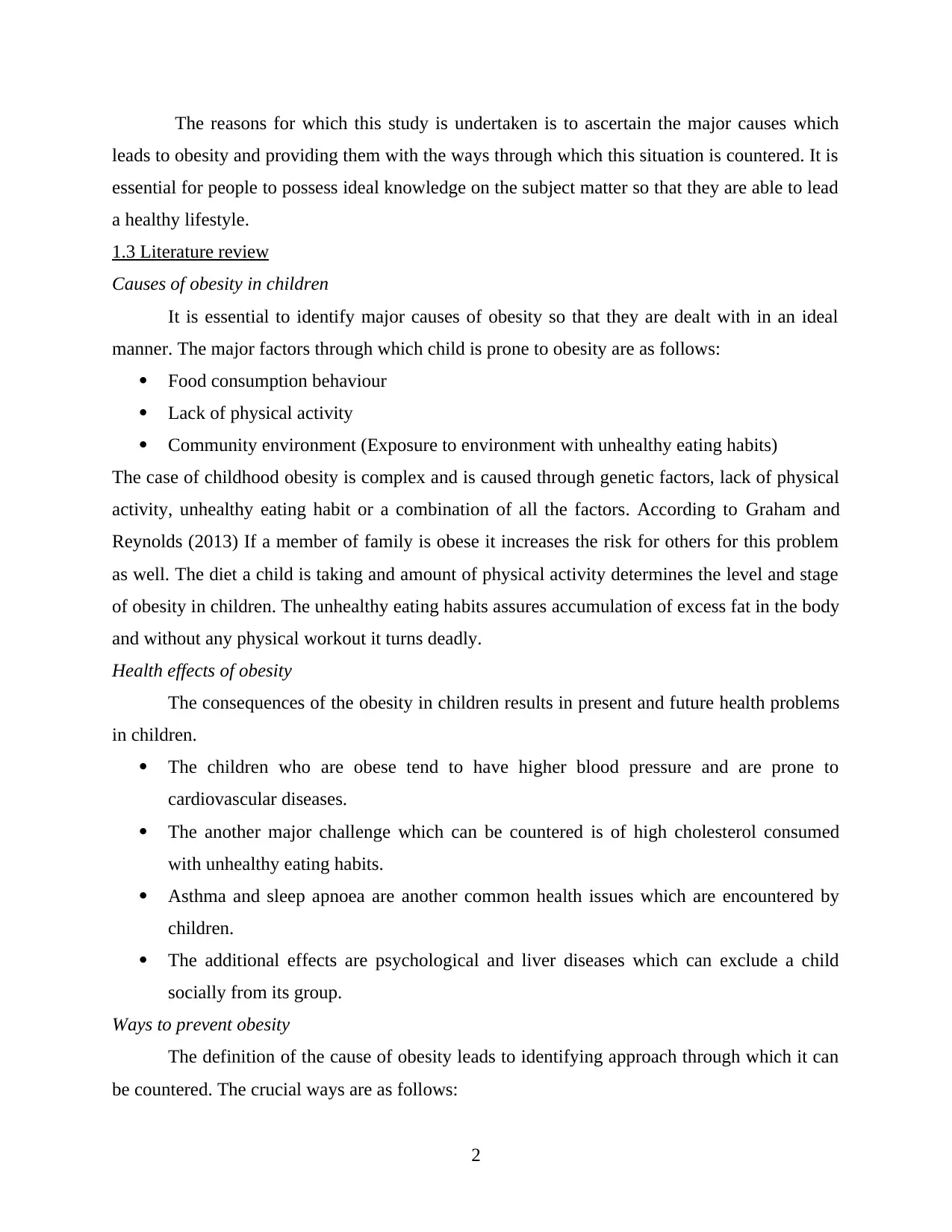
The reasons for which this study is undertaken is to ascertain the major causes which
leads to obesity and providing them with the ways through which this situation is countered. It is
essential for people to possess ideal knowledge on the subject matter so that they are able to lead
a healthy lifestyle.
1.3 Literature review
Causes of obesity in children
It is essential to identify major causes of obesity so that they are dealt with in an ideal
manner. The major factors through which child is prone to obesity are as follows:
Food consumption behaviour
Lack of physical activity
Community environment (Exposure to environment with unhealthy eating habits)
The case of childhood obesity is complex and is caused through genetic factors, lack of physical
activity, unhealthy eating habit or a combination of all the factors. According to Graham and
Reynolds (2013) If a member of family is obese it increases the risk for others for this problem
as well. The diet a child is taking and amount of physical activity determines the level and stage
of obesity in children. The unhealthy eating habits assures accumulation of excess fat in the body
and without any physical workout it turns deadly.
Health effects of obesity
The consequences of the obesity in children results in present and future health problems
in children.
The children who are obese tend to have higher blood pressure and are prone to
cardiovascular diseases.
The another major challenge which can be countered is of high cholesterol consumed
with unhealthy eating habits.
Asthma and sleep apnoea are another common health issues which are encountered by
children.
The additional effects are psychological and liver diseases which can exclude a child
socially from its group.
Ways to prevent obesity
The definition of the cause of obesity leads to identifying approach through which it can
be countered. The crucial ways are as follows:
2
leads to obesity and providing them with the ways through which this situation is countered. It is
essential for people to possess ideal knowledge on the subject matter so that they are able to lead
a healthy lifestyle.
1.3 Literature review
Causes of obesity in children
It is essential to identify major causes of obesity so that they are dealt with in an ideal
manner. The major factors through which child is prone to obesity are as follows:
Food consumption behaviour
Lack of physical activity
Community environment (Exposure to environment with unhealthy eating habits)
The case of childhood obesity is complex and is caused through genetic factors, lack of physical
activity, unhealthy eating habit or a combination of all the factors. According to Graham and
Reynolds (2013) If a member of family is obese it increases the risk for others for this problem
as well. The diet a child is taking and amount of physical activity determines the level and stage
of obesity in children. The unhealthy eating habits assures accumulation of excess fat in the body
and without any physical workout it turns deadly.
Health effects of obesity
The consequences of the obesity in children results in present and future health problems
in children.
The children who are obese tend to have higher blood pressure and are prone to
cardiovascular diseases.
The another major challenge which can be countered is of high cholesterol consumed
with unhealthy eating habits.
Asthma and sleep apnoea are another common health issues which are encountered by
children.
The additional effects are psychological and liver diseases which can exclude a child
socially from its group.
Ways to prevent obesity
The definition of the cause of obesity leads to identifying approach through which it can
be countered. The crucial ways are as follows:
2
Secure Best Marks with AI Grader
Need help grading? Try our AI Grader for instant feedback on your assignments.
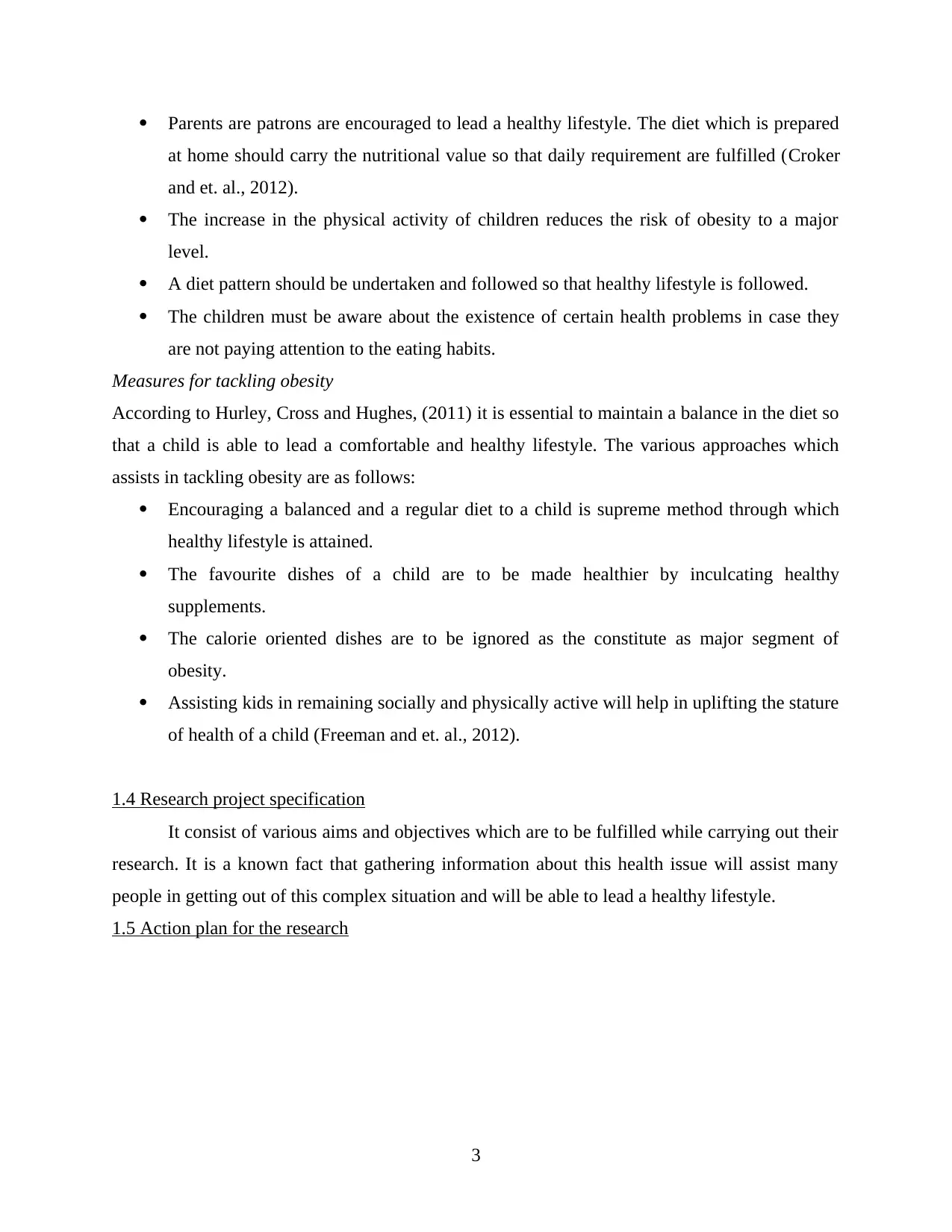
Parents are patrons are encouraged to lead a healthy lifestyle. The diet which is prepared
at home should carry the nutritional value so that daily requirement are fulfilled (Croker
and et. al., 2012).
The increase in the physical activity of children reduces the risk of obesity to a major
level.
A diet pattern should be undertaken and followed so that healthy lifestyle is followed.
The children must be aware about the existence of certain health problems in case they
are not paying attention to the eating habits.
Measures for tackling obesity
According to Hurley, Cross and Hughes, (2011) it is essential to maintain a balance in the diet so
that a child is able to lead a comfortable and healthy lifestyle. The various approaches which
assists in tackling obesity are as follows:
Encouraging a balanced and a regular diet to a child is supreme method through which
healthy lifestyle is attained.
The favourite dishes of a child are to be made healthier by inculcating healthy
supplements.
The calorie oriented dishes are to be ignored as the constitute as major segment of
obesity.
Assisting kids in remaining socially and physically active will help in uplifting the stature
of health of a child (Freeman and et. al., 2012).
1.4 Research project specification
It consist of various aims and objectives which are to be fulfilled while carrying out their
research. It is a known fact that gathering information about this health issue will assist many
people in getting out of this complex situation and will be able to lead a healthy lifestyle.
1.5 Action plan for the research
3
at home should carry the nutritional value so that daily requirement are fulfilled (Croker
and et. al., 2012).
The increase in the physical activity of children reduces the risk of obesity to a major
level.
A diet pattern should be undertaken and followed so that healthy lifestyle is followed.
The children must be aware about the existence of certain health problems in case they
are not paying attention to the eating habits.
Measures for tackling obesity
According to Hurley, Cross and Hughes, (2011) it is essential to maintain a balance in the diet so
that a child is able to lead a comfortable and healthy lifestyle. The various approaches which
assists in tackling obesity are as follows:
Encouraging a balanced and a regular diet to a child is supreme method through which
healthy lifestyle is attained.
The favourite dishes of a child are to be made healthier by inculcating healthy
supplements.
The calorie oriented dishes are to be ignored as the constitute as major segment of
obesity.
Assisting kids in remaining socially and physically active will help in uplifting the stature
of health of a child (Freeman and et. al., 2012).
1.4 Research project specification
It consist of various aims and objectives which are to be fulfilled while carrying out their
research. It is a known fact that gathering information about this health issue will assist many
people in getting out of this complex situation and will be able to lead a healthy lifestyle.
1.5 Action plan for the research
3
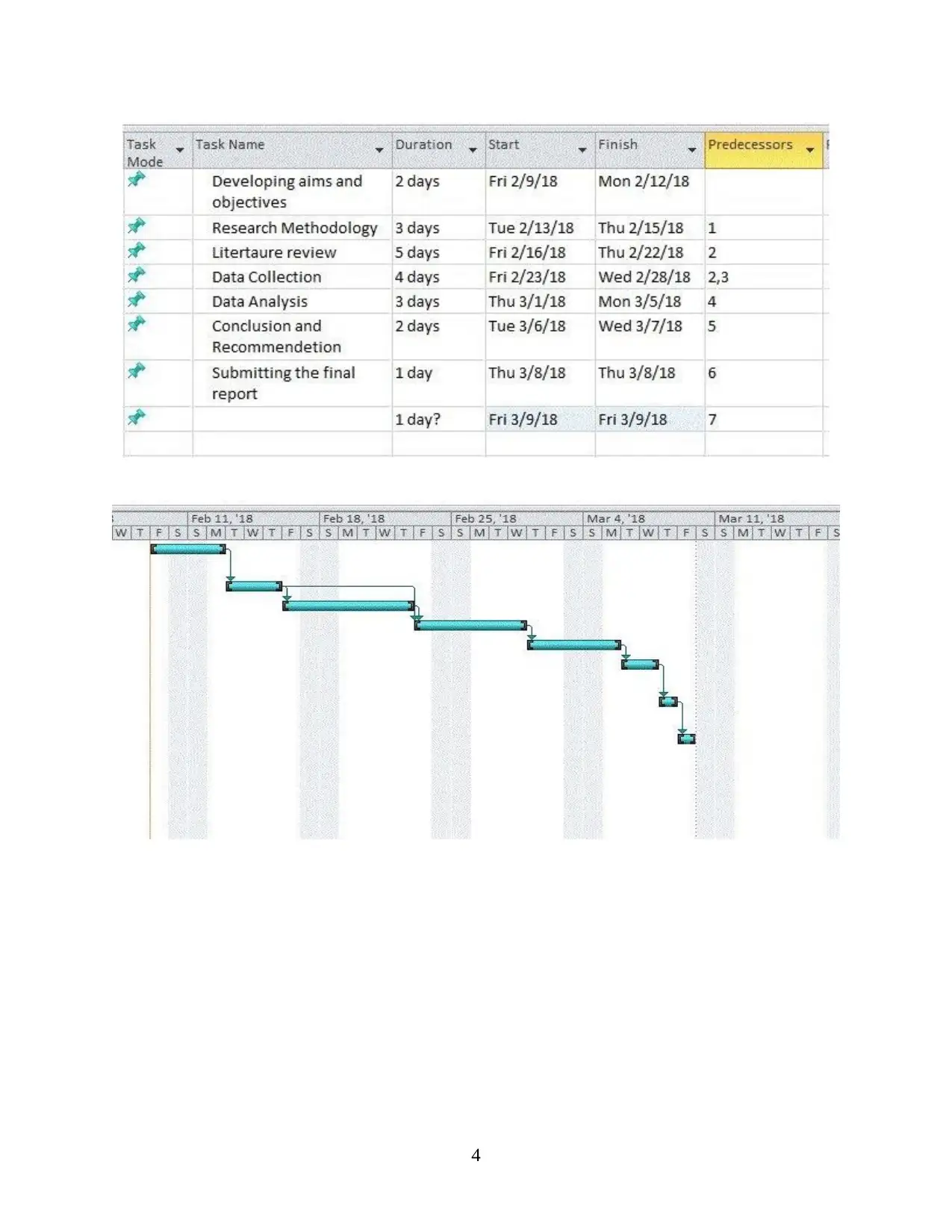
4
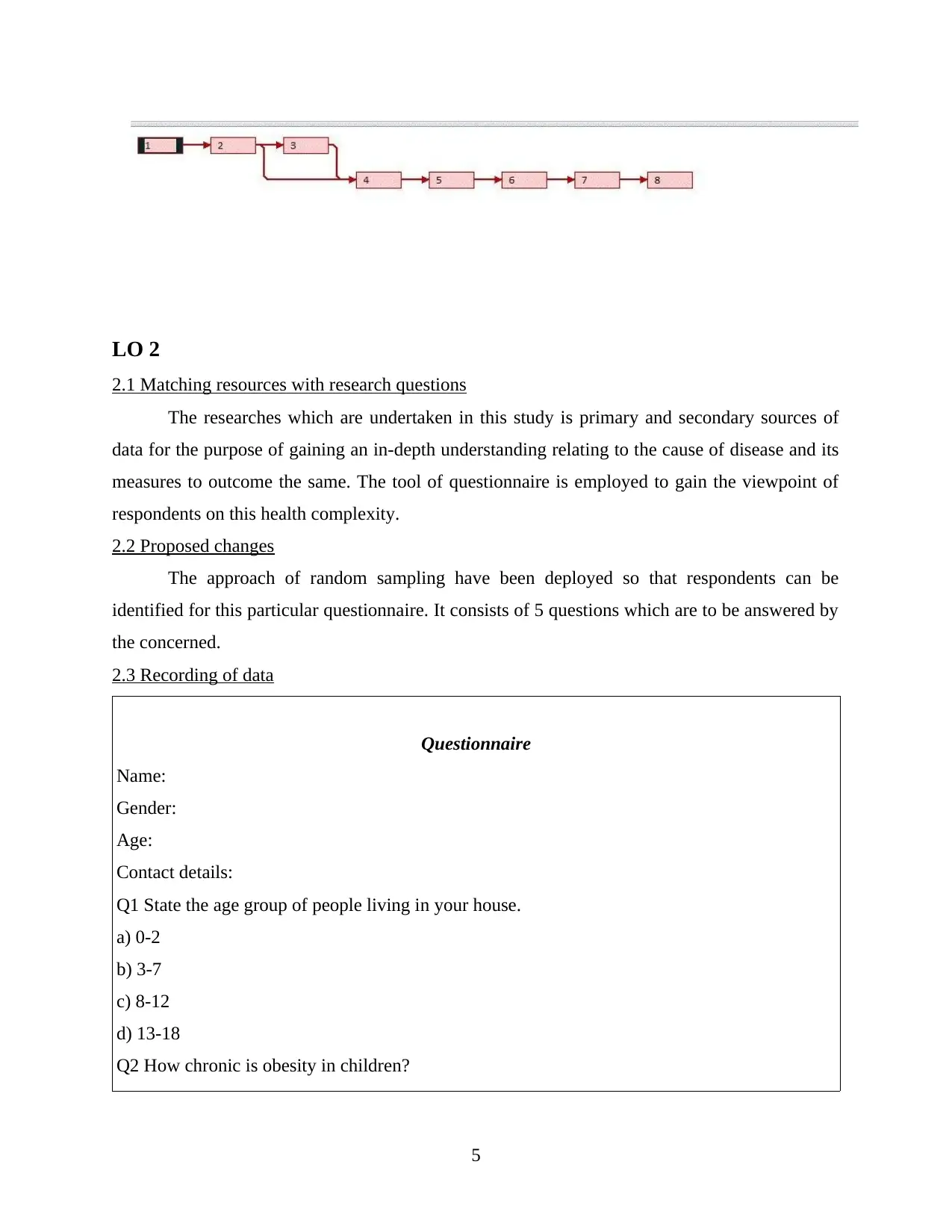
LO 2
2.1 Matching resources with research questions
The researches which are undertaken in this study is primary and secondary sources of
data for the purpose of gaining an in-depth understanding relating to the cause of disease and its
measures to outcome the same. The tool of questionnaire is employed to gain the viewpoint of
respondents on this health complexity.
2.2 Proposed changes
The approach of random sampling have been deployed so that respondents can be
identified for this particular questionnaire. It consists of 5 questions which are to be answered by
the concerned.
2.3 Recording of data
Questionnaire
Name:
Gender:
Age:
Contact details:
Q1 State the age group of people living in your house.
a) 0-2
b) 3-7
c) 8-12
d) 13-18
Q2 How chronic is obesity in children?
5
2.1 Matching resources with research questions
The researches which are undertaken in this study is primary and secondary sources of
data for the purpose of gaining an in-depth understanding relating to the cause of disease and its
measures to outcome the same. The tool of questionnaire is employed to gain the viewpoint of
respondents on this health complexity.
2.2 Proposed changes
The approach of random sampling have been deployed so that respondents can be
identified for this particular questionnaire. It consists of 5 questions which are to be answered by
the concerned.
2.3 Recording of data
Questionnaire
Name:
Gender:
Age:
Contact details:
Q1 State the age group of people living in your house.
a) 0-2
b) 3-7
c) 8-12
d) 13-18
Q2 How chronic is obesity in children?
5
Paraphrase This Document
Need a fresh take? Get an instant paraphrase of this document with our AI Paraphraser
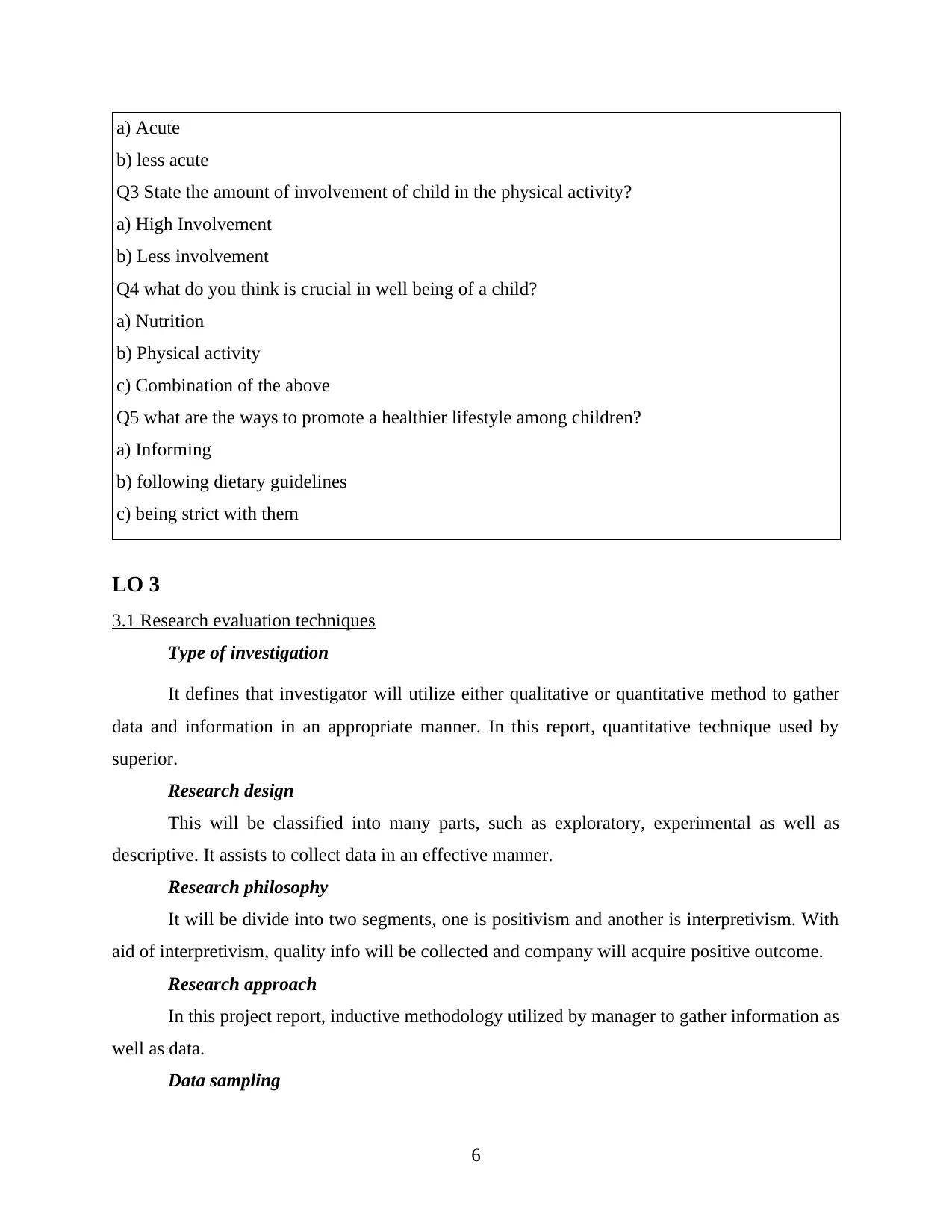
a) Acute
b) less acute
Q3 State the amount of involvement of child in the physical activity?
a) High Involvement
b) Less involvement
Q4 what do you think is crucial in well being of a child?
a) Nutrition
b) Physical activity
c) Combination of the above
Q5 what are the ways to promote a healthier lifestyle among children?
a) Informing
b) following dietary guidelines
c) being strict with them
LO 3
3.1 Research evaluation techniques
Type of investigation
It defines that investigator will utilize either qualitative or quantitative method to gather
data and information in an appropriate manner. In this report, quantitative technique used by
superior.
Research design
This will be classified into many parts, such as exploratory, experimental as well as
descriptive. It assists to collect data in an effective manner.
Research philosophy
It will be divide into two segments, one is positivism and another is interpretivism. With
aid of interpretivism, quality info will be collected and company will acquire positive outcome.
Research approach
In this project report, inductive methodology utilized by manager to gather information as
well as data.
Data sampling
6
b) less acute
Q3 State the amount of involvement of child in the physical activity?
a) High Involvement
b) Less involvement
Q4 what do you think is crucial in well being of a child?
a) Nutrition
b) Physical activity
c) Combination of the above
Q5 what are the ways to promote a healthier lifestyle among children?
a) Informing
b) following dietary guidelines
c) being strict with them
LO 3
3.1 Research evaluation techniques
Type of investigation
It defines that investigator will utilize either qualitative or quantitative method to gather
data and information in an appropriate manner. In this report, quantitative technique used by
superior.
Research design
This will be classified into many parts, such as exploratory, experimental as well as
descriptive. It assists to collect data in an effective manner.
Research philosophy
It will be divide into two segments, one is positivism and another is interpretivism. With
aid of interpretivism, quality info will be collected and company will acquire positive outcome.
Research approach
In this project report, inductive methodology utilized by manager to gather information as
well as data.
Data sampling
6
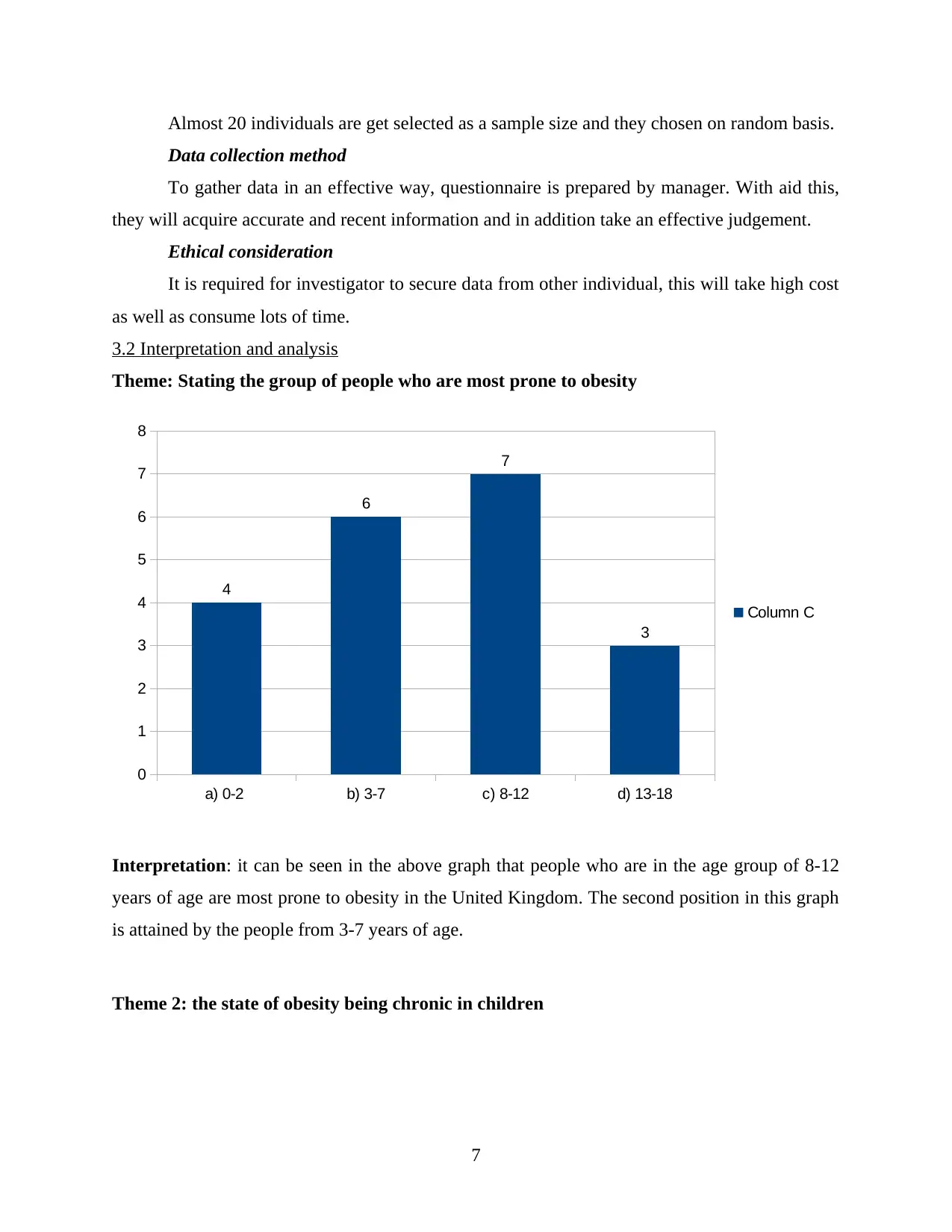
Almost 20 individuals are get selected as a sample size and they chosen on random basis.
Data collection method
To gather data in an effective way, questionnaire is prepared by manager. With aid this,
they will acquire accurate and recent information and in addition take an effective judgement.
Ethical consideration
It is required for investigator to secure data from other individual, this will take high cost
as well as consume lots of time.
3.2 Interpretation and analysis
Theme: Stating the group of people who are most prone to obesity
Interpretation: it can be seen in the above graph that people who are in the age group of 8-12
years of age are most prone to obesity in the United Kingdom. The second position in this graph
is attained by the people from 3-7 years of age.
Theme 2: the state of obesity being chronic in children
7
a) 0-2 b) 3-7 c) 8-12 d) 13-18
0
1
2
3
4
5
6
7
8
4
6
7
3
Column C
Data collection method
To gather data in an effective way, questionnaire is prepared by manager. With aid this,
they will acquire accurate and recent information and in addition take an effective judgement.
Ethical consideration
It is required for investigator to secure data from other individual, this will take high cost
as well as consume lots of time.
3.2 Interpretation and analysis
Theme: Stating the group of people who are most prone to obesity
Interpretation: it can be seen in the above graph that people who are in the age group of 8-12
years of age are most prone to obesity in the United Kingdom. The second position in this graph
is attained by the people from 3-7 years of age.
Theme 2: the state of obesity being chronic in children
7
a) 0-2 b) 3-7 c) 8-12 d) 13-18
0
1
2
3
4
5
6
7
8
4
6
7
3
Column C
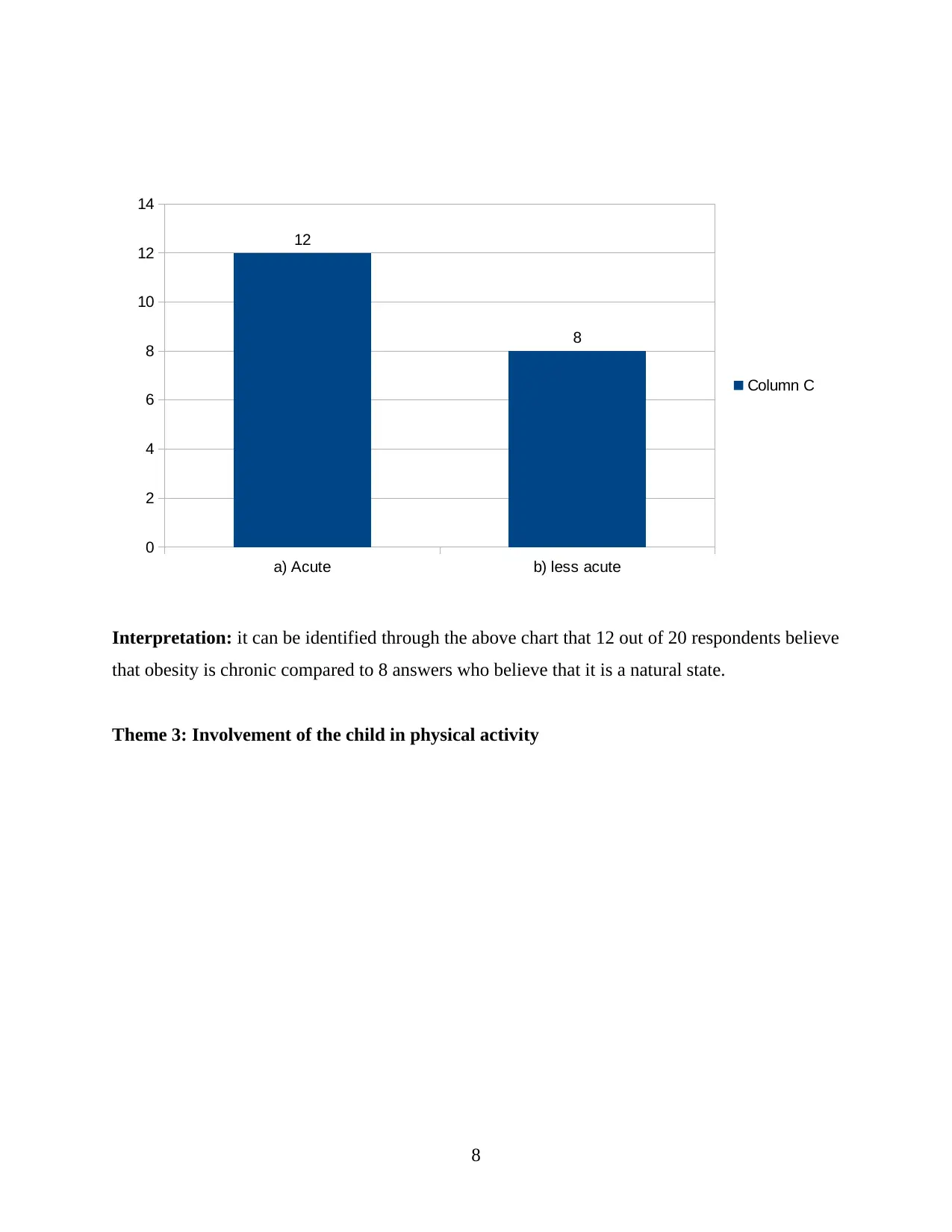
Interpretation: it can be identified through the above chart that 12 out of 20 respondents believe
that obesity is chronic compared to 8 answers who believe that it is a natural state.
Theme 3: Involvement of the child in physical activity
8
a) Acute b) less acute
0
2
4
6
8
10
12
14
12
8
Column C
that obesity is chronic compared to 8 answers who believe that it is a natural state.
Theme 3: Involvement of the child in physical activity
8
a) Acute b) less acute
0
2
4
6
8
10
12
14
12
8
Column C
Secure Best Marks with AI Grader
Need help grading? Try our AI Grader for instant feedback on your assignments.
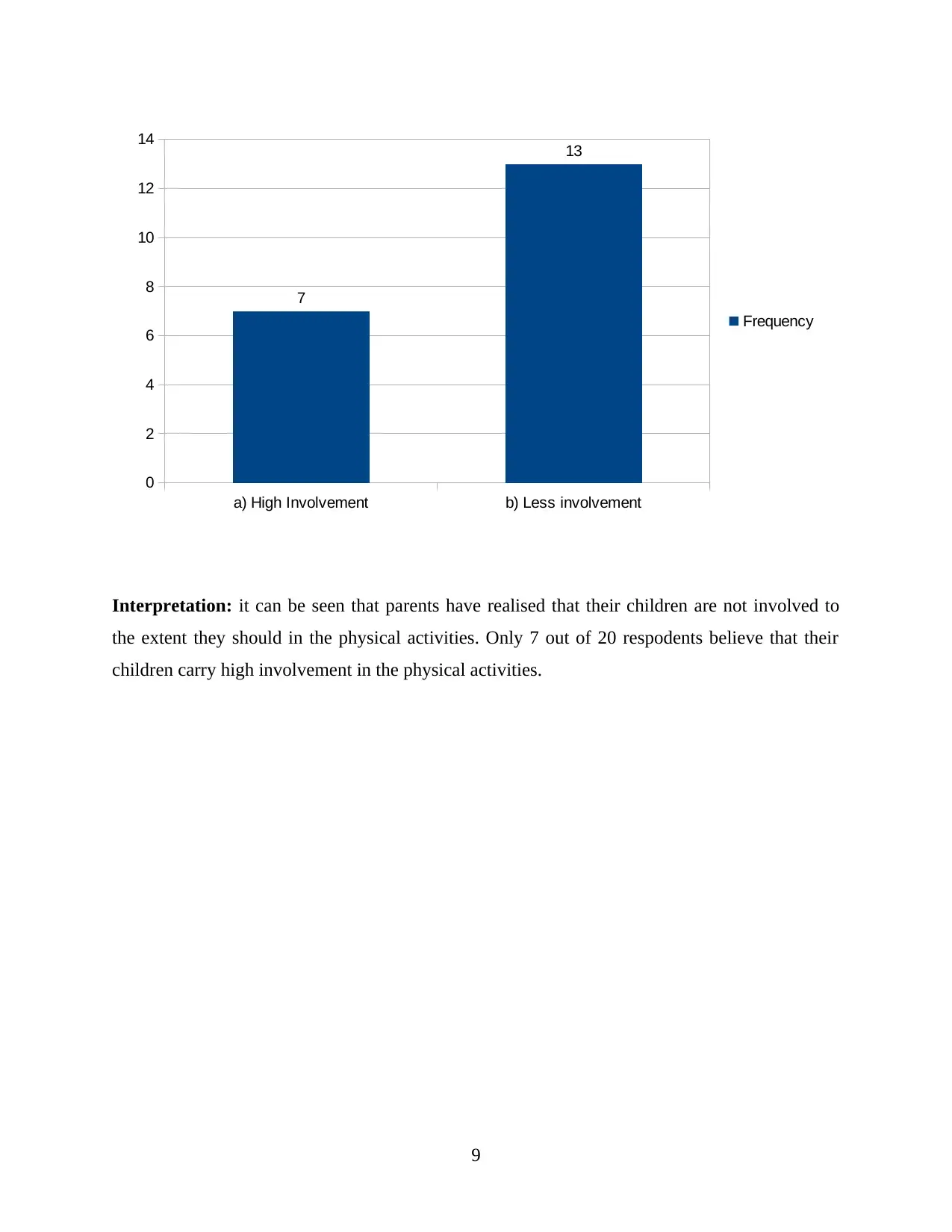
Interpretation: it can be seen that parents have realised that their children are not involved to
the extent they should in the physical activities. Only 7 out of 20 respodents believe that their
children carry high involvement in the physical activities.
9
a) High Involvement b) Less involvement
0
2
4
6
8
10
12
14
7
13
Frequency
the extent they should in the physical activities. Only 7 out of 20 respodents believe that their
children carry high involvement in the physical activities.
9
a) High Involvement b) Less involvement
0
2
4
6
8
10
12
14
7
13
Frequency
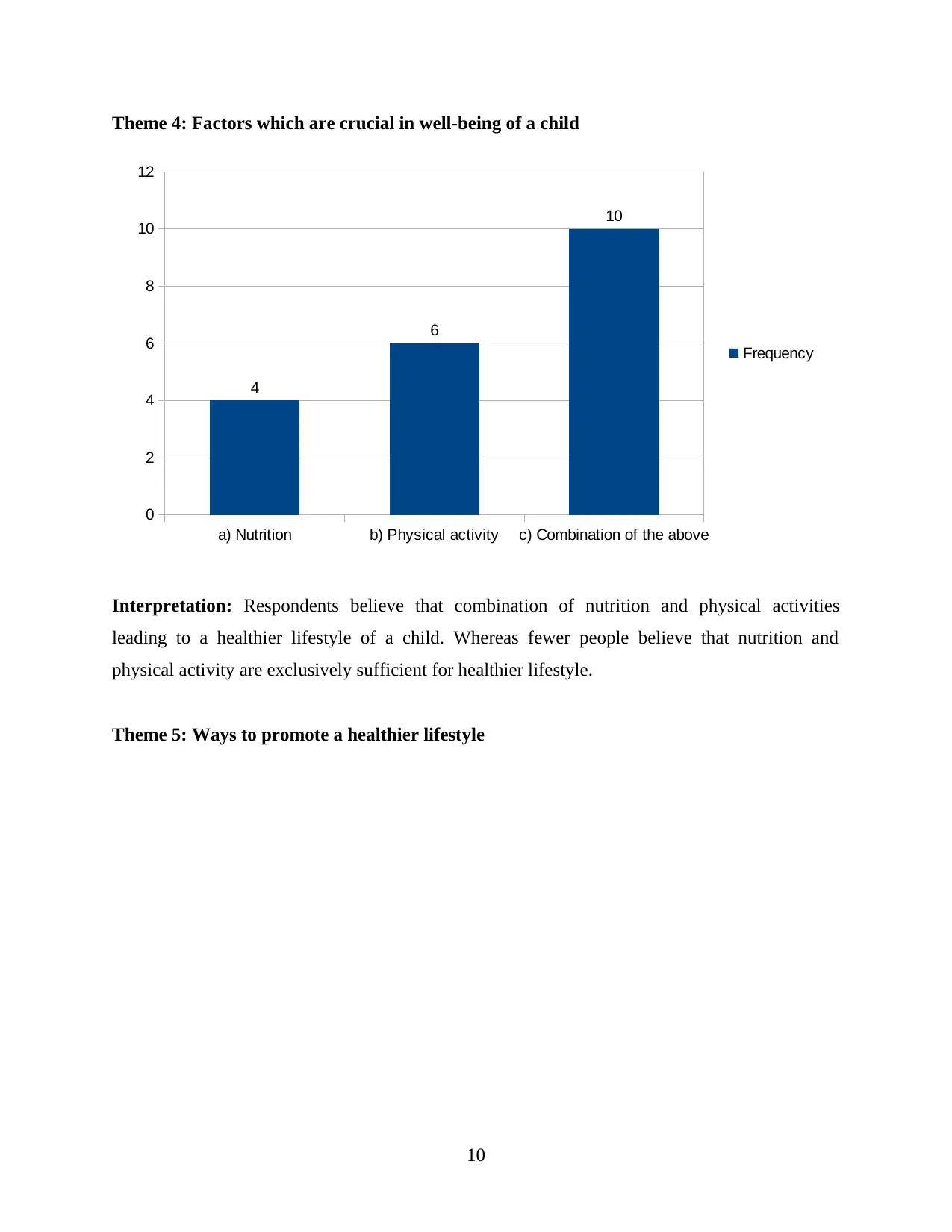
Theme 4: Factors which are crucial in well-being of a child
Interpretation: Respondents believe that combination of nutrition and physical activities
leading to a healthier lifestyle of a child. Whereas fewer people believe that nutrition and
physical activity are exclusively sufficient for healthier lifestyle.
Theme 5: Ways to promote a healthier lifestyle
10
a) Nutrition b) Physical activity c) Combination of the above
0
2
4
6
8
10
12
4
6
10
Frequency
Interpretation: Respondents believe that combination of nutrition and physical activities
leading to a healthier lifestyle of a child. Whereas fewer people believe that nutrition and
physical activity are exclusively sufficient for healthier lifestyle.
Theme 5: Ways to promote a healthier lifestyle
10
a) Nutrition b) Physical activity c) Combination of the above
0
2
4
6
8
10
12
4
6
10
Frequency
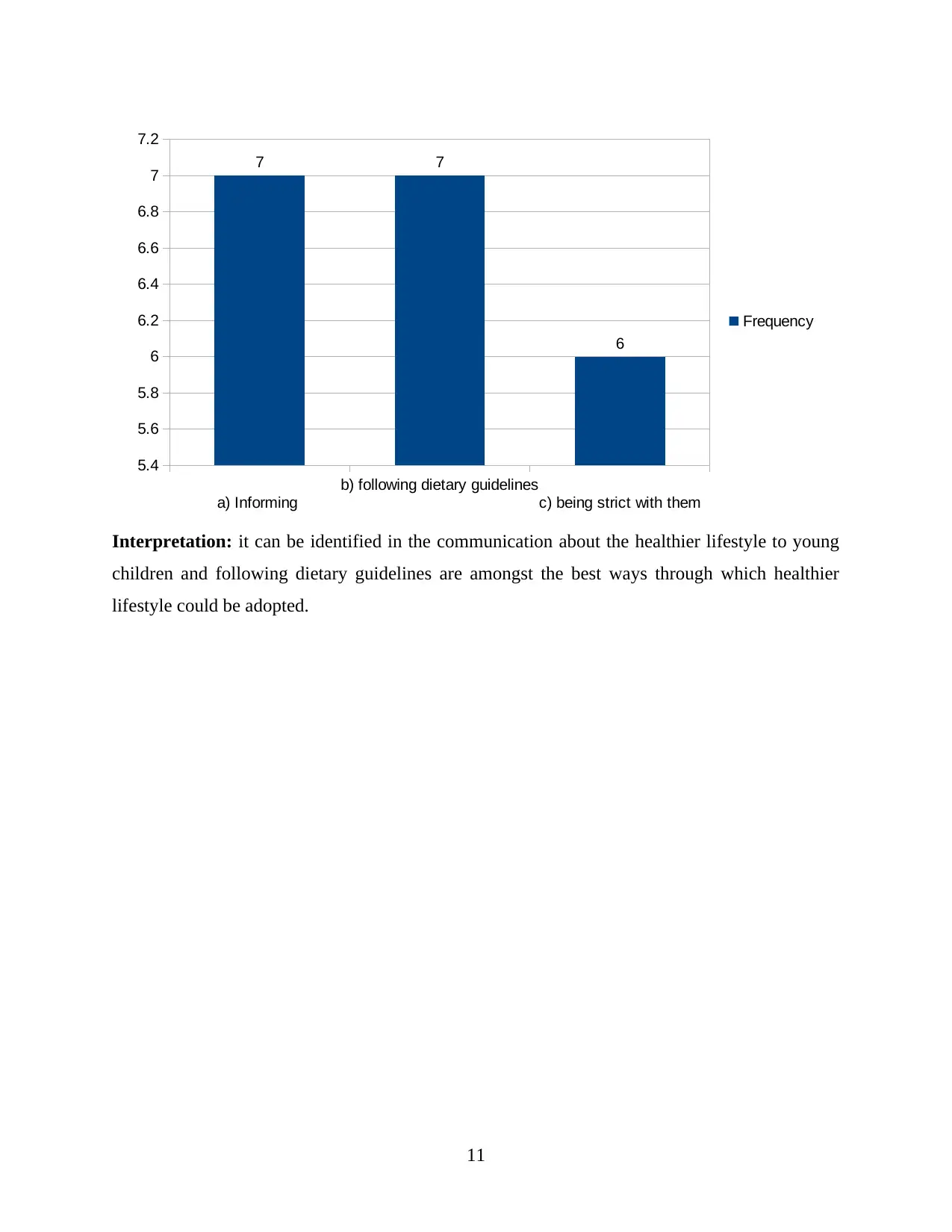
Interpretation: it can be identified in the communication about the healthier lifestyle to young
children and following dietary guidelines are amongst the best ways through which healthier
lifestyle could be adopted.
11
a) Informing
b) following dietary guidelines
c) being strict with them
5.4
5.6
5.8
6
6.2
6.4
6.6
6.8
7
7.2
7 7
6
Frequency
children and following dietary guidelines are amongst the best ways through which healthier
lifestyle could be adopted.
11
a) Informing
b) following dietary guidelines
c) being strict with them
5.4
5.6
5.8
6
6.2
6.4
6.6
6.8
7
7.2
7 7
6
Frequency
Paraphrase This Document
Need a fresh take? Get an instant paraphrase of this document with our AI Paraphraser
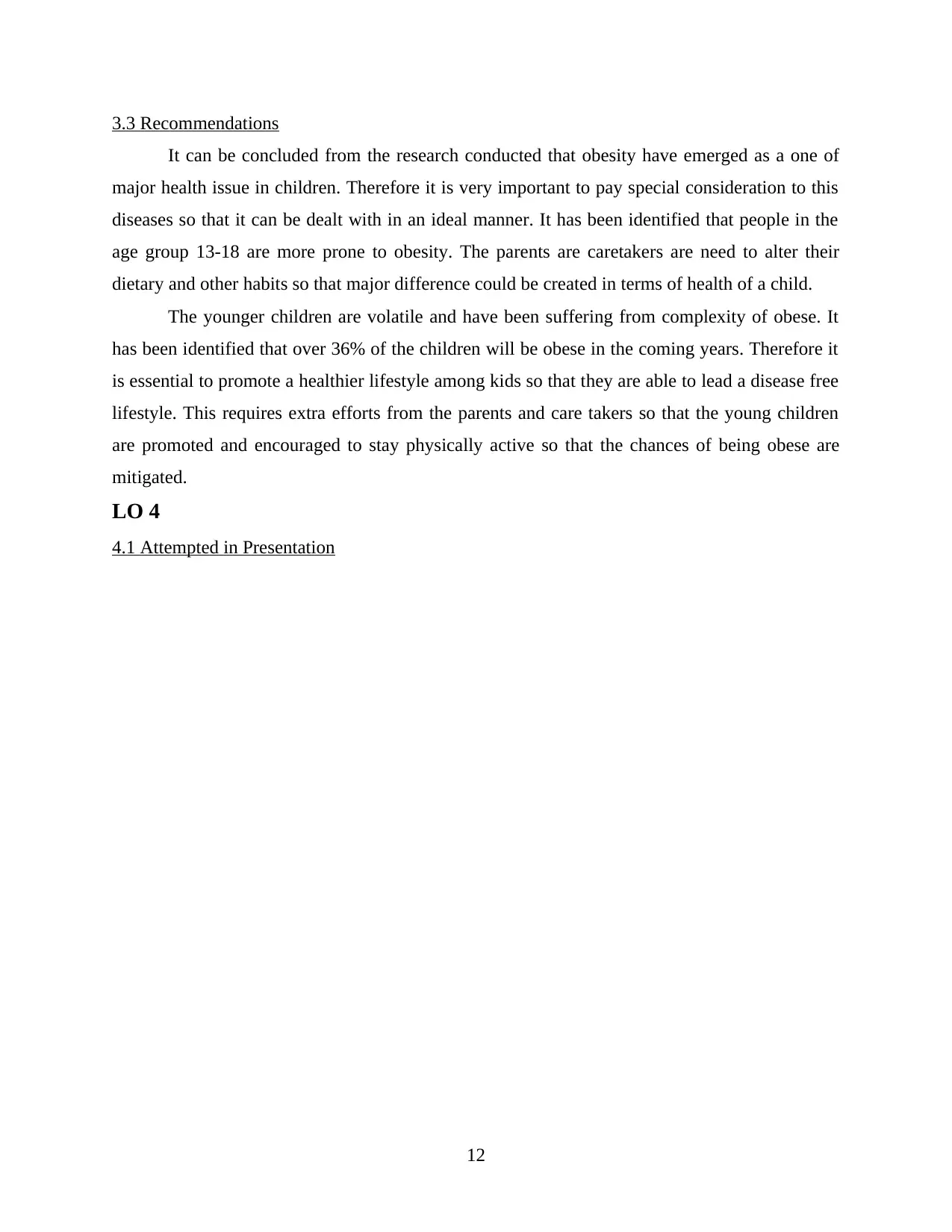
3.3 Recommendations
It can be concluded from the research conducted that obesity have emerged as a one of
major health issue in children. Therefore it is very important to pay special consideration to this
diseases so that it can be dealt with in an ideal manner. It has been identified that people in the
age group 13-18 are more prone to obesity. The parents are caretakers are need to alter their
dietary and other habits so that major difference could be created in terms of health of a child.
The younger children are volatile and have been suffering from complexity of obese. It
has been identified that over 36% of the children will be obese in the coming years. Therefore it
is essential to promote a healthier lifestyle among kids so that they are able to lead a disease free
lifestyle. This requires extra efforts from the parents and care takers so that the young children
are promoted and encouraged to stay physically active so that the chances of being obese are
mitigated.
LO 4
4.1 Attempted in Presentation
12
It can be concluded from the research conducted that obesity have emerged as a one of
major health issue in children. Therefore it is very important to pay special consideration to this
diseases so that it can be dealt with in an ideal manner. It has been identified that people in the
age group 13-18 are more prone to obesity. The parents are caretakers are need to alter their
dietary and other habits so that major difference could be created in terms of health of a child.
The younger children are volatile and have been suffering from complexity of obese. It
has been identified that over 36% of the children will be obese in the coming years. Therefore it
is essential to promote a healthier lifestyle among kids so that they are able to lead a disease free
lifestyle. This requires extra efforts from the parents and care takers so that the young children
are promoted and encouraged to stay physically active so that the chances of being obese are
mitigated.
LO 4
4.1 Attempted in Presentation
12
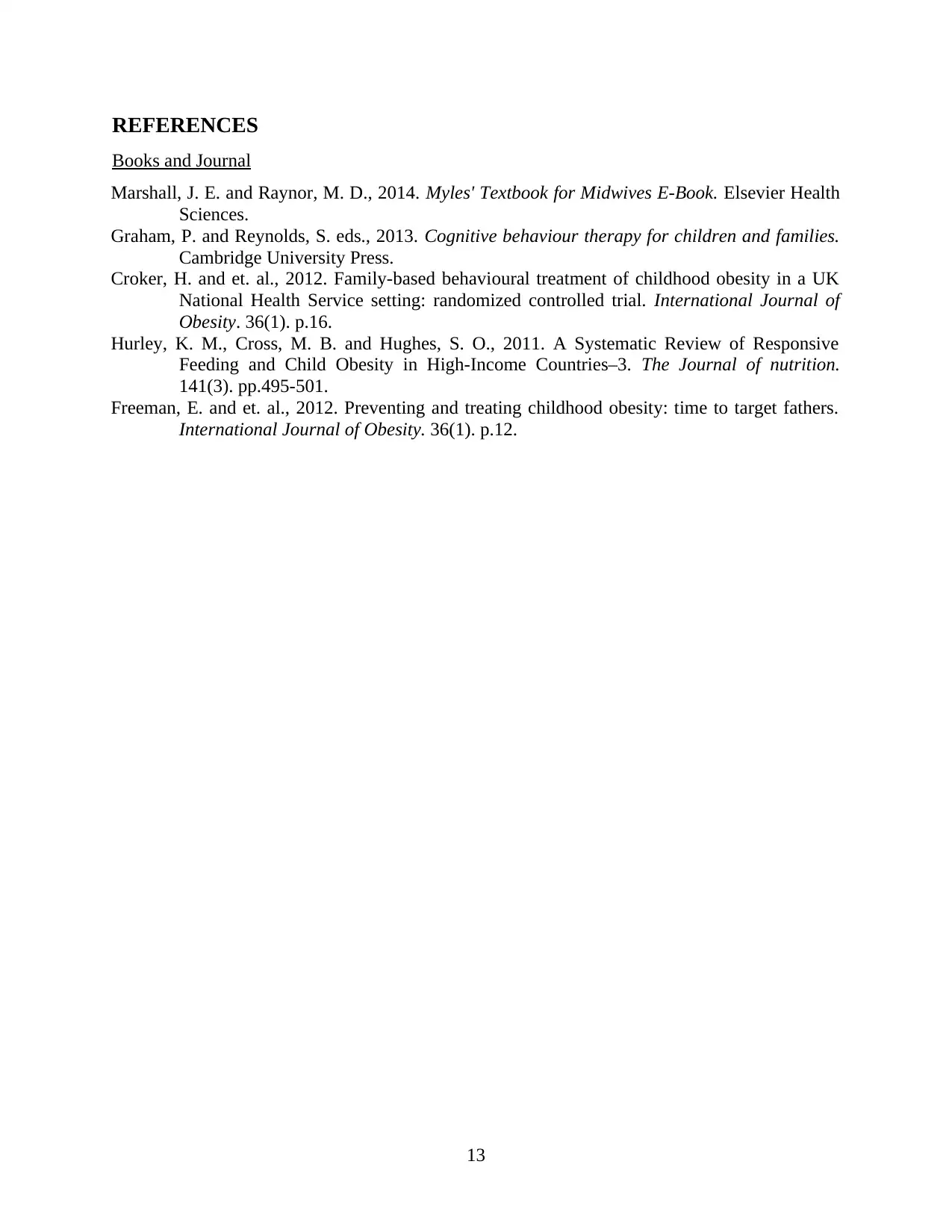
REFERENCES
Books and Journal
Marshall, J. E. and Raynor, M. D., 2014. Myles' Textbook for Midwives E-Book. Elsevier Health
Sciences.
Graham, P. and Reynolds, S. eds., 2013. Cognitive behaviour therapy for children and families.
Cambridge University Press.
Croker, H. and et. al., 2012. Family-based behavioural treatment of childhood obesity in a UK
National Health Service setting: randomized controlled trial. International Journal of
Obesity. 36(1). p.16.
Hurley, K. M., Cross, M. B. and Hughes, S. O., 2011. A Systematic Review of Responsive
Feeding and Child Obesity in High-Income Countries–3. The Journal of nutrition.
141(3). pp.495-501.
Freeman, E. and et. al., 2012. Preventing and treating childhood obesity: time to target fathers.
International Journal of Obesity. 36(1). p.12.
13
Books and Journal
Marshall, J. E. and Raynor, M. D., 2014. Myles' Textbook for Midwives E-Book. Elsevier Health
Sciences.
Graham, P. and Reynolds, S. eds., 2013. Cognitive behaviour therapy for children and families.
Cambridge University Press.
Croker, H. and et. al., 2012. Family-based behavioural treatment of childhood obesity in a UK
National Health Service setting: randomized controlled trial. International Journal of
Obesity. 36(1). p.16.
Hurley, K. M., Cross, M. B. and Hughes, S. O., 2011. A Systematic Review of Responsive
Feeding and Child Obesity in High-Income Countries–3. The Journal of nutrition.
141(3). pp.495-501.
Freeman, E. and et. al., 2012. Preventing and treating childhood obesity: time to target fathers.
International Journal of Obesity. 36(1). p.12.
13
1 out of 15
Related Documents
Your All-in-One AI-Powered Toolkit for Academic Success.
+13062052269
info@desklib.com
Available 24*7 on WhatsApp / Email
![[object Object]](/_next/static/media/star-bottom.7253800d.svg)
Unlock your academic potential
© 2024 | Zucol Services PVT LTD | All rights reserved.





